Hidden or Hidden?
This part of the puzzle is about if it’s not the old who are actually entering into new self-employment, who is it really?
The Resolution Foundation’s report published today looked at self-employment in the UK from all sorts of angles and in considerable detail by age, occupation, region etc … and is well worth the read. And pleased to see that it chimed with my thoughts on cohort effect.
The paper’s broad conclusion is
The analysis paints a worrying picture of the security and vulnerability of self- employed people on both a short and long term horizon
It notes
The self-employed now account for one in every seven people in employment.
And in answer it seems to the puzzling question as to who are the newly self-employed,
the self-employed do not look significantly different to before the recession; there are just more of them.
Well there’s no point in keeping anyone in suspense, as they might not otherwise read to the end, so what follows seeks to demonstrate – with the greatest respect – that virtually the entire change in the numbers of the self-employed since the recession can be attributed to migrants to the UK.
This in no way detracts from the Resolution Foundation’s headline conclusion – in fact it probably reinforces it. Nor does it mean the dynamic changes within the self-employed population as a whole that the paper identifies are any less important. But in terms of identifying structural change, and to inform policy thinking both from the perspective of labour market slack and addressing issues of vulnerability and security at the individual level, I’d suggest that it merits at least some mention or examination.
Of people born abroad who are working in the UK, 1 in 5 is self-employed, and they also comprise nearly 1 in 5 of the total number of self-employed who are of working age.
The UK labour market is not a closed system, and in recent years barriers to entry have been lower for the self-employed too. If all those declaring self-employment as their main job are identified by country of birth, it looks as though about a third of the increase in self-employment between 2008Q4 and 2013Q4 has resulted from migration.
Figure #1
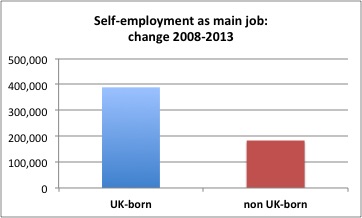
(source: ONS UK Labour Force Survey 2008Q4 and 2013Q4)
But then we have to take account of the fact that the only ‘real’ increase is among those of working age. Comparing change in numbers of working age people gives this picture instead, showing quite a difference in number and the relative contribution to growth in numbers.
Figure #2
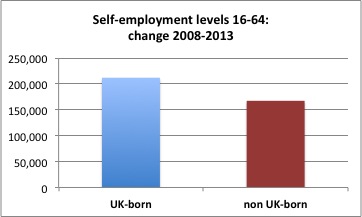
(source: ONS UK Labour Force Survey 2008Q4 and 2013Q4)
Now let’s look at how much of the increase in numbers is down to part-time rather than full-time work. Remember that this is employment in main job, so even the part-time self-employment here is not just a sideline to more substantive employment elsewhere. Clearly part-time self-employment is a significant factor in the growth in self-employment in both groups, but rather more in the UK-born.
Figure #3
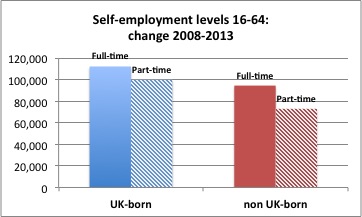
(source: ONS UK Labour Force Survey 2008Q4 and 2013Q4)
Although the contribution of the non UK-born to the increase in self-employment is overall slightly less than for the UK-born, of course that hides the extent of any percentage change. Total self-employment among UK-born people of working age increased over the period by nearly 7%, but among non UK-born people by just over 30%.
Figure #4
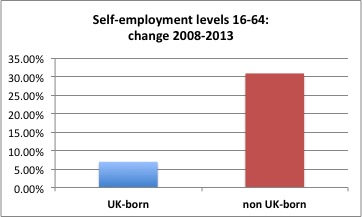
It might be thought that this is a reflection of migrants finding barriers to getting work as an employee, and relative ease of setting up on one’s own as self-employed. Or indeed being required to do so as a condition of employment in certain sectors where work is liable to be subcontracted or carried out on an agency basis. In both cases that would represent as much ‘necessity’ as ‘opportunity’. But if we look at levels of employment as an employee in the same way as we have at self-employment, that does not seem to be implied very strongly. In fact, among people of working age, there has been significant growth in the numbers of non UK-born workers across both categories of employment and both working patterns. In contrast, there has been a significant drop in the number of UK-born full-time employees that has been only partly outweighed by increases in both kinds of self-employment, with numbers of part-time employees shrinking too but only by a negligible amount.
Figure #5
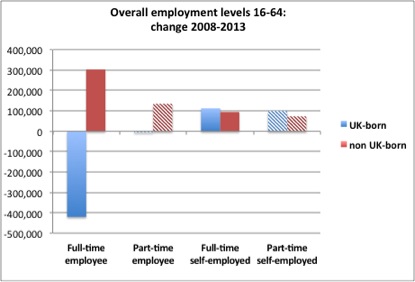
(source: ONS UK Labour Force Survey 2008Q4 and 2013Q4)
In view of the nature of these components of the recent and much remarked-upon growth in self-employment, and their potential implications for business and for policy, it seems odd that the ONS analysis looked at in my first piece on this puzzle produced only the conclusion that older people have contributed most to the rise in self-employment. That analysis seems to have been prompted by the very ‘dramatic’ rise in self-employment in the latter half of 2013. While dramatic, it isn’t actually even recently unprecedented, as looking at quarterly figures, there was actually a greater rise over as short a period in 2003.
Figure #6
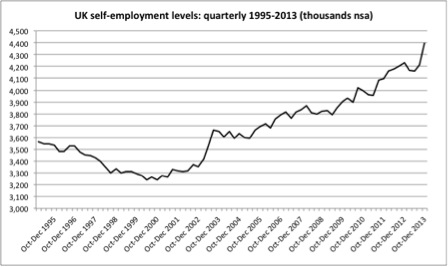
(source: ONS Emp09 Feb 2014)
Bearing in mind that part of the puzzle is to identify and distinguish structural from cyclical drivers, it’s worth noting that the pictures above for change over the five years from 2008Q4 to 2013Q4 hide the quite remarkable difference made by the last two quarters. Moving the series back two quarters (to ensure no difference in seasonality), the migration component of growth in self-employment looks quite different from Figures 1-3 above.
Figure #7
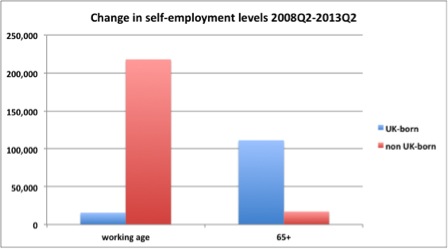
(source: ONS UK Labour Force Survey 2008Q2 and 2013Q2)
Putting the change over these five years alongside the change in the two following quarters gives this picture
Figure #8
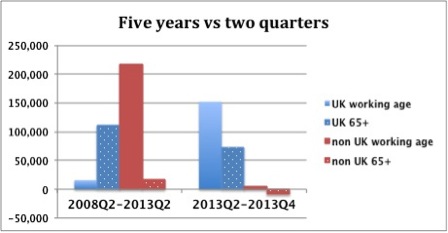
(source: ONS UK Labour Force Survey 2008Q2 and 2013Q2 and Q4)
So it looks as though the most recent increases aren’t necessarily indicative of trend as in this key regard they are completely different from what has occurred over the previous five years. The biggest structural drivers over this period (whether taking the most recent quarters into account or not) appear to be
• Ageing of a population of UK-born self-employed who are continuing in work post retirement and
• Increasing numbers of migrants to the UK entering self-employment.
In the five years up until mid-2013, migrants to the UK account for almost the entire overall growth in numbers among working-age people.
Obviously, the non UK-born include people who have been in the UK for a very long time, so to illustrate something about whether more recent migrants are driving the change here are the ‘top 20’ countries by total numbers in the UK who are self-employed, showing the level of self-employment in 2008, and the change since then.
Figure #9
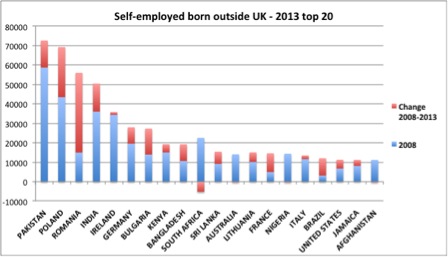
(source: ONS UK Labour Force Survey 2008Q4 and 2013Q4)
The countries of birth contributing most to change over the last five years clearly suggest that much of the change results from more recent migrants rather than people who have been in the UK for many years.
To the extent that the growth in self-employment might be associated with lower incomes and greater insecurity, it is possible that these and any other adverse effects of recent self-employment might have a disproportionate impact on migrants to the UK.
This look at the data makes no claim to be exhaustive, and simply seeks to point out that there is at least one way in which the self-employed look increasingly different than from before the recession, and the key observation that over this period there was a net increase in self-employment only among working-age people, and that a very large part of this contribution to growth derived from the non UK-born.
It is a further puzzle why in the second half of 2013, not until then, and only then, the numbers of UK-born self-employed of working age increased so dramatically after five years of essentially no change at all!
(obviously to be further continued …..)
Some other puzzlers ...
Resolution Foundation
The newly self-employed are likely to be suffer from some vulnerability and insecurity. But they don't appear to be much different in any key characteristic from the existing self-employed. Link to their report is here
Morgan Stanley
There are five key drivers of increases in UK self-employment. Overall these suggest the growth derives from weakness in the economy and is a sign of slack. Their report should download here.
Steven Toft (@FlipChartRick)
Increased self-employment doesn't appear to be necessarily a good thing, looked at internationally and macro-economically here
Benedict Dellot from the RSA
Growing self-employment results from opportunity not necessity, and suggestions to the contrary are myths to be busted here
Adam Lent from the RSA
High self-employment rates aren't a sign of economic weakness, but stirring entrepreneurial spirit here
TUC
The growth of self-employment is part of a trend towards casualised work, likely to hold back wages, and prevent people from having the kind of secure employment they need to pay their bills, save money and plan for the future here
Jonathan Portes
Writing in Financial World, Jonathan puzzles over the lack of productivity rebound from recession, and wonders whether ground has been lost permanently here.